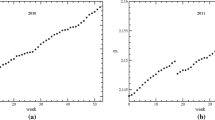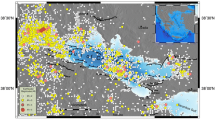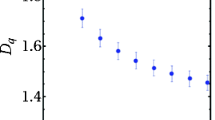Abstract
This paper studies the statistical distributions of worldwide earthquakes from year 1963 up to year 2012. A Cartesian grid, dividing Earth into geographic regions, is considered. Entropy and the Jensen–Shannon divergence are used to analyze and compare real-world data. Hierarchical clustering and multi-dimensional scaling techniques are adopted for data visualization. Entropy-based indices have the advantage of leading to a single parameter expressing the relationships between the seismic data. Classical and generalized (fractional) entropy and Jensen–Shannon divergence are tested. The generalized measures lead to a clear identification of patterns embedded in the data and contribute to better understand earthquake distributions.













Similar content being viewed by others
References
Aggarwal, C.C., Hinneburg, A., Keim, D.A.: On the Surprising Behavior of Distance Metrics in High Dimensional Space. Springer, New York (2001)
Ashtari Jafari, M.: Statistical prediction of the next great earthquake around Tehran, Iran. J. Geodyn. 49(1), 14–18 (2010)
Balasis, G., Daglis, I.A., Papadimitriou, C., Anastasiadis, A., Sandberg, I., Eftaxias, K.: Quantifying dynamical complexity of magnetic storms and solar flares via nonextensive Tsallis entropy. Entropy 13(10), 1865–1881 (2011)
Baleanu, D., Diethelm, K., Scalas, E., Trujillo, J.J.: Fractional Calculus. World Scientific, Singapore (2012)
Bhattacharya, P., Chakrabarti, B.K., et al.: A fractal model of earthquake occurrence: theory, simulations and comparisons with the aftershock data. In: Journal of Physics: conference series, vol. 319, pp. 012004. IOP Publishing (2011)
Carlson, J.M., Langer, J.S., Shaw, B.E.: Dynamics of earthquake faults. Rev. Mod. Phys. 66(2), 657 (1994)
Clauset, A., Young, M., Gleditsch, K.S.: On the frequency of severe terrorist events. J. Confl. Resolut. 51(1), 58–87 (2007)
Cover, T.M., Thomas, J.A.: Elements of Information Theory. Wiley, New York (2012)
Cox, T.F., Cox, M.A.: Multidimensional Scaling. CRC Press, Boca Raton (2000)
Das, R., Wason, H., Sharma, M.: Magnitude conversion to unified moment magnitude using orthogonal regression relation. J. Asian Earth Sci. 50, 44–51 (2012)
De Rubeis, V., Hallgass, R., Loreto, V., Paladin, G., Pietronero, L., Tosi, P.: Self-affine asperity model for earthquakes. Phys. Rev. Lett. 76(14), 2599 (1996)
De Santis, A., Cianchini, G., Favali, P., Beranzoli, L., Boschi, E.: The Gutenberg–Richter law and entropy of earthquakes: two case studies in Central Italy. Bull. Seismol. Soc. Am. 101(3), 1386–1395 (2011)
Ekström, G., Nettles, M., Abers, G.A.: Glacial earthquakes. Science 302(5645), 622–624 (2003)
Geller, R.J.: Earthquake prediction: a critical review. Geophys. J. Int. 131(3), 425–450 (1997)
Goltz, C., Böse, M.: Configurational entropy of critical earthquake populations. Geophys. Res. Lett. 29(20), 51 (2002)
Gutenberg, B., Richter, C.F.: Frequency of earthquakes in California. Bull. Seismol. Soc. Am. 34(4), 185–188 (1944)
Hallgass, R., Loreto, V., Mazzella, O., Paladin, G., Pietronero, L.: Earthquake statistics and fractal faults. Phys. Rev. E 56(2), 1346 (1997)
Hartigan, J.A.: Clustering Algorithms. Wiley, New York (1975)
Hartigan, J.A., Wong, M.A.: Algorithm as 136: A K-means clustering algorithm. Appl. Stat. 28(1), 100–108 (1979)
Hussein, H., Elenean, K.A., Marzouk, I., Peresan, A., Korrat, I., El-Nader, E.A., Panza, G., El-Gabry, M.: Integration and magnitude homogenization of the egyptian earthquake catalogue. Nat. Hazards 47(3), 525–546 (2008)
International Seismological Centre: On-line Bulletin. International Seismological Centre, Thatcham, United Kingdom (2012). http://www.isc.ac.uk
Ionescu, C.M.: The Human Respiratory System; An Analysis of the Interplay between Anatomy, Structure, Breathing and Fractal Dynamics. Springer, New York (2013)
Jain, A.K.: Data clustering: 50 years beyond k-means. Pattern Recognit. Lett. 31(8), 651–666 (2010)
Kagan, Y.Y.: Seismic moment distribution revisited: I. Statistical results. Geophys. J. Int. 148(3), 520–541 (2002)
Kagan, Y.Y., Jackson, D.D.: Probabilistic forecasting of earthquakes. Geophys. J. Int. 143(2), 438–453 (2000)
Kanamori, H., Brodsky, E.E.: The physics of earthquakes. Rep. Prog. Phys. 67(8), 1429 (2004)
Keilis-Borok, V.: The lithosphere of the earth as a nonlinear system with implications for earthquake prediction. Rev. Geophys. 28(1), 19–34 (1990)
Khinchin, A.I.: Mathematical Foundations of Information Theory, vol. 434. Courier Dover Publications, New York (1957)
Levada, A.: Learning from complex systems: on the roles of entropy and Fisher information in pairwise isotropic gaussian Markov random fields. Entropy 16(2), 1002–1036 (2014)
Lopes, A.M., Tenreiro Machado, J.A., Pinto, C., Galhano, A.: Multidimensional scaling visualization of earthquake phenomena. J. Seismol. 18(1), 163–179 (2014)
Lopes, A.M., Tenreiro Machado, J.A., Pinto, C., Galhano, A.: Fractional dynamics and MDS visualization of earthquake phenomena. Comput. Math. Appl. 66(5), 647–658 (2013)
Machado, J.T.: Fractional order generalized information. Entropy 16(4), 2350–2361 (2014)
Martínez-Torres, M.R., García, F.B., Marín, S.T., Vázquez, S.G.: A digital signal processing teaching methodology using concept-mapping techniques. IEEE Trans. Educ. 48(3), 422–429 (2005)
Mega, M.S., Allegrini, P., Grigolini, P., Latora, V., Palatella, L., Rapisarda, A., Vinciguerra, S.: Power-law time distribution of large earthquakes. Phys. Rev. Lett. 90(18), 188,501 (2003)
Mignan, A., Woessner, J.: Estimating the magnitude of completeness for earthquake catalogs. Community Online Resour. Stat. Seism. Anal. (2012). doi:10.5078/corssa-00180805
Nicholson, T., Sambridge, M., Gudmundsson, O.: On entropy and clustering in earthquake hypocentre distributions. Geophys. J. Int. 142(1), 37–51 (2000)
Ōmori, F.: On the After-Shocks of Earthquakes, vol. 7. The University, Tokyo (1894)
Peng, Z., Gomberg, J.: An integrated perspective of the continuum between earthquakes and slow-slip phenomena. Nature Geosci 3(9), 599–607 (2010)
Pinto, C., Mendes Lopes, A., Tenreiro Machado, J.A.: A review of power laws in real life phenomena. Commun. Nonlinear Sci. Numer. Simul. 17(9), 3558–3578 (2012)
Rousseeuw, P.J.: Silhouettes: a graphical aid to the interpretation and validation of cluster analysis. J. Comput. Appl. Math. 20, 53–65 (1987)
Sarlis, N., Christopoulos, S.R.: Natural time analysis of the centennial earthquake catalog. Chaos Interdiscip. J. Nonlinear Sci. 22(2), 023,123 (2012)
Scordilis, E.: Empirical global relations converting \(m_s\) and \(m_b\) to moment magnitude. J. Seismol. 10(2), 225–236 (2006)
Seely, A.J., Newman, K.D., Herry, C.L.: Fractal structure and entropy production within the central nervous system. Entropy 16(8), 4497–4520 (2014)
Sokal, R.R., Rohlf, F.J.: The comparison of dendrograms by objective methods. Taxon. 11(2), 33–40 (1962)
Sornette, A., Sornette, D.: Earthquake rupture as a critical point: Consequences for telluric precursors. Tectonophysics 179(3), 327–334 (1990)
Sornette, D.: Earthquakes: from chemical alteration to mechanical rupture. Phys. Rep. 313(5), 237–292 (1999)
Sotolongo-Costa, O., Posadas, A.: Fragment-asperity interaction model for earthquakes. Physical Rev. Lett. 92(4), 048,501 (2004)
Stadler, G., Gurnis, M., Burstedde, C., Wilcox, L.C., Alisic, L., Ghattas, O.: The dynamics of plate tectonics and mantle flow: from local to global scales. Science 329(5995), 1033–1038 (2010)
Stein, S., Liu, M., Calais, E., Li, Q.: Mid-continent earthquakes as a complex system. Seismol. Res. Lett. 80(4), 551–553 (2009)
Stucchi, M., Albini, P., Mirto, M., Rebez, A.: Assessing the completeness of italian historical earthquake data. Ann. Geophys. 47(2–3), 659–673 (2004)
Tenreiro Machado, J.A., Lopes, A.M.: Analysis and visualization of seismic data using mutual information. Entropy 15(9), 3892–3909 (2013)
Turcotte, D.L., Malamud, B.D.: Earthquakes as a complex system. Int. Geophys. 81, 209-IV (2002)
Utsu, T., Ogata, Y., Matsu’ura, R.S.: The centenary of the Omori formula for a decay law of aftershock activity. J. Phys. Earth 43(1), 1–33 (1995)
Valério, D., Trujillo, J.J., Rivero, M., Tenreiro Machado, J.A., Baleanu, D.: Fractional calculus: a survey of useful formulas. Eur. Phys. J. Spec. Top. 222, 1827–1846 (2013)
Wiemer, S.: A software package to analyze seismicity: Zmap. Seismol. Res. Lett. 72(3), 373–382 (2001)
Acknowledgments
The authors acknowledge the International Seismological Centre (ISC) for the data (http://www.isc.ac.uk/).
Author information
Authors and Affiliations
Corresponding author
Ethics declarations
Conflict of interest
The authors declare that they have no conflict of interest.
Rights and permissions
About this article
Cite this article
Lopes, A.M., Tenreiro Machado, J.A. Integer and fractional-order entropy analysis of earthquake data series. Nonlinear Dyn 84, 79–90 (2016). https://doi.org/10.1007/s11071-015-2231-x
Received:
Accepted:
Published:
Issue Date:
DOI: https://doi.org/10.1007/s11071-015-2231-x




